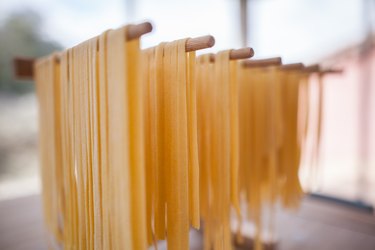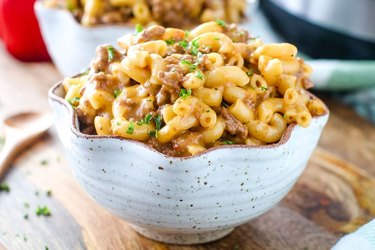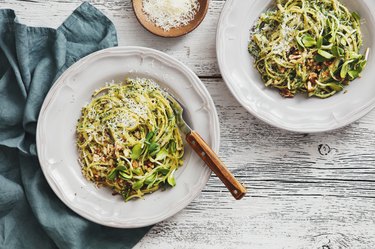
Pasta has become as American as apple pie. There's nothing wrong with eating pasta from a box, but when you have the time and energy to make fresh pasta, you'll be rewarded with tender, tastier noodles.
Making pasta from scratch means you can control the ingredients used. Add some quality homemade sauce, chop a few herbs, heat up frozen vegetables for a side dish, and you have a fast and convenient meal with your own fresh pasta as the base. Just know that when you make your own fresh pasta, you'll probably want to make and store several batches because it'll likely be a hit at the table.
Video of the Day
Video of the Day
Below we share a few best practices on how to dry and store fresh pasta, as well as a few tips on how to perfect your homemade pasta dough.
Drying Homemade Pasta
The great thing about making your own pasta is that you can flavor it any way you want — add spinach or tomatoes, or spice it up with garlic or hot pepper. And it's nice when you can make a large quantity of pasta at once and then separate it into meal-sized portions to keep on hand, ready to pop into boiling water.
If you're making pasta using a pasta maker, King Arthur Flour suggests doing the following:
- Lay the silky strips of pasta in one layer on a baking sheet
- Store in a dry area for 12 to 24 hours
Flour is fickle, so humidity, temperature and the size of the noodles all make a difference in drying homemade pasta. A fan can help.
You can also try drying the pasta in the oven, draping your pasta strips over your oven rack with the oven turned off.
You want the pasta dry enough to snap, not bend, when twisted. Then you can store it in airtight containers at room temperature.
Tip
King Arthur suggests avoiding making pasta on very humid days. If that's not an option, freeze the noodles into nests then after you make the pasta.
How to Dry Pasta Using a Dehydrator
There's an easier way to dry your pasta if you own a food dehydrator. Dehydrator manufacturer Excalibur recommends doing the following:
- Place the fresh strips of pasta in single layers onto drying trays
- Dry for two to four hours at 135 degrees Fahrenheit
- Store in airtight packages
Iowa State University Extension and Outreach suggests using a food dehydrator if you make pasta with eggs in it. Store the dried egg pasta in airtight bags in the freezer.
Freezing Homemade Pasta
Another way to store pasta for several weeks is to freeze it — and you don't even have to dry it. Toss fresh pasta with a little flour and store in airtight bags.
Let fresh pasta dry on a rack for an hour before freezing. You don't need to separate strands of pasta before freezing, but you should dust them with flour and form them into nests, per KitchenAid.
Freezing and drying pasta in nests makes it easier to separate the strands when you thaw the pasta.
If you want to freeze it, King Arthur Flour recommends you place cut pasta pieces on a baking sheet and freeze them for 15 minutes or until they don't stick together. Once they're semifrozen, transfer the pieces to airtight bags, label and date them, and freeze.
How Long Does Homemade Dried Pasta Last?
Unlike the pasta you grab at the grocery store, homemade pasta can only last 2 to 6 months when dried, according to KitchenAid. Frozen homemade pasta can last about 8 months in the freezer and fresh homemade pasta will only last a day in the fridge.
Making the Pasta
King Arthur Flour suggests using flour, egg and water.
Use one large egg per cup of flour, plus 2 to 3 tablespoons of water, as needed. The flour can be all-purpose, whole-wheat or semolina, or any combination of these. Italian-style is best for delicate sheet pasta, like lasagna. Pastry and cake flours are too soft for pasta, per King Arthur.
Oil and salt are best left to the pasta water rather than the pasta dough, according to King Arthur. You'll need a dough that's dry for ziti, penne or macaroni. It will need to pass through the extruder of your pasta maker without sticking.
Softer pasta dough will have added water; this is for lasagna, manicotti or ravioli. This type of dough can also be cut into fettuccine, linguine or other flat shapes.
Good Dough Consistency
King Arthur Flour says to keep an eye on the consistency of the dough when mixing the ingredients. Use a dough hook instead of a beater — if you have one.
Pasta for extruders will be drier and look like pie dough. It won't form a ball easily. This will make it dry enough for a clean cut, and you'll want softer dough to roll the pasta.
Here's where you get the pasta ready for storage. If you want to cook some right away, put it into a pot of boiling water. Spread the pasta that's to be stored on a baking sheet, or put it into your dehydrator.
Decide if you want to dry your pasta completely or freeze it. If you decide to dry it and store it, remember King Arthur's advice to dry it for 12 to 24 hours on a day when the humidity is down, and store the pasta in airtight bags when it's dry enough to snap. If it's a humid day, your best solution might be to freeze the pasta, following the instructions outlined.
Cooking With Dried Pasta
And after you've decided on a storage method, you can rest easy knowing you can make and dry fresh pasta, and save it for those busy nights when you have little time to cook.
When you cook with your own dried pasta, remember not to cook it the way you would packaged dry pasta. King Arthur Flour says homemade pasta cooks much more quickly than commercially dried pasta.
King Arthur's suggestions on cooking pasta are:
Fresh pasta, no drying or freezing: 2 to 3 minutes
Fresh pasta, frozen: 3 to 5 minutes, depending on size
Fresh pasta, air-dried: 4 to 7 minutes, depending on size
Commercially dried pasta: 6 to 10 minutes, depending on size
Try for the al dente texture — you want just a bit of bite. The pasta shouldn't be too crunchy or too soft.
Boil the water in a large pot, then let it get to a rolling boil and then add the pasta. Add 1 1/2 teaspoons of salt for every 3.5 ounces of pasta, and don't use a lid.
When the pasta is ready, save a little bit of the boiled water to add to your sauce, which helps it stick to the pasta. Top your fresh pasta with sauce, and enjoy!


